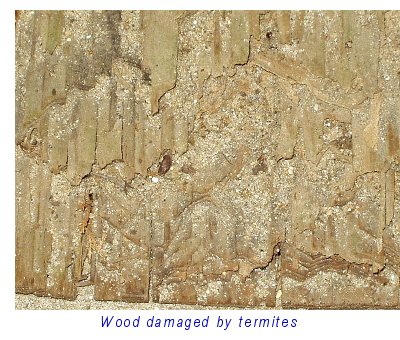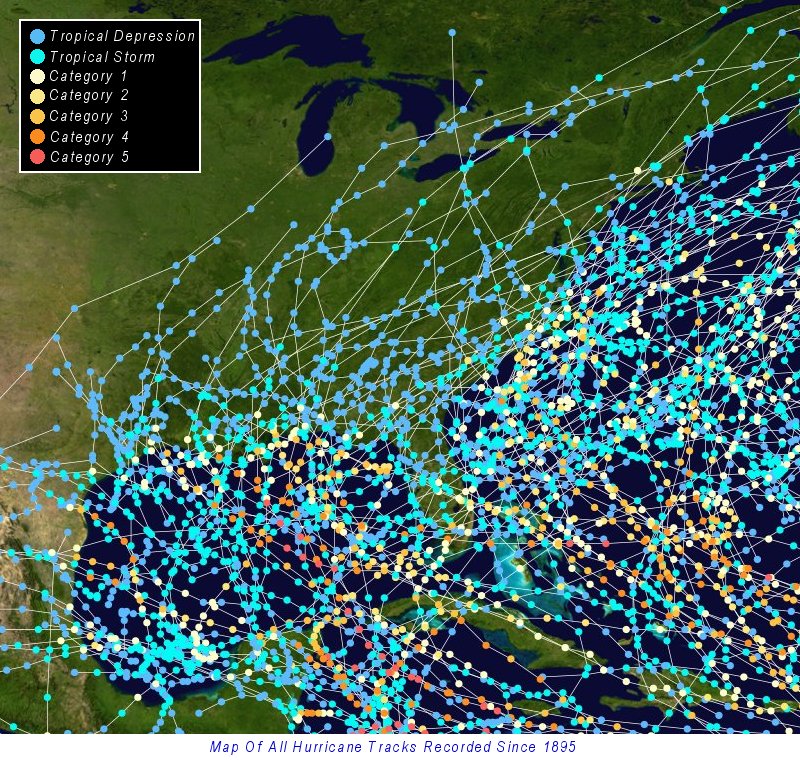| |||||||||
| Table of Contents | |||
|
1. Water Leaks Prevention Inspections 2. Home Fires Electrical Fires Your Escape Plan 3. Pollution Hazards Carbon Monoxide Radon Natural Gas Leaks Indoor Pollution 4. Pest Attacks Termite Infestations Termite Inspections Termite Prevention Tips If Termites Strike Rodents Roach Control |
5. The Human Element Home Insurance Traps Make A Household Inventory Con Men Contractors Burglars 6. Home Accidents Falls Poisoning 7. Natural Disasters Earthquakes Hurricanes Lightning Drownings 8. Planning Ahead Basic Disaster Supplies Kit Maintaining Your Kit Create An Evacuation Box Final Thoughts | ||
Of course, no one can prevent natural disasters like earthquakes and hurricanes. But in many cases you can prevent other insidious disasters from affecting your home: home fires, insect pests and burglars for example. And even in the case of natural disasters, The Disaster Prevention Blueprint can still either (a) prevent disasters from affecting you, or (b) if they do happen, minimize the damage caused to your home and family. You are wise to have procured this report, because otherwise problems can easily go from bad to terrible -- especially for those who are not prepared. The tips in this report will help you deal with disaster before it strikes.
Water Leaks
Water leaks in a home can cause major damage: your foundation
could buckle, an aging roof might collapse, and it can also lead
to a disastrous infestation of mold or mildew. Other problems
include rotting of wood, wood expansion and buckling, rusting of
metals and splitting of laminated materials such as plywood and
Formica. If mold is left to grow, it can lead to a repair bill
of $30,000 or more. Breathing mold spores can also be bad for
your health and sometimes deadly. Noticing mold early and
removing by a thorough cleaning with bleach and water saves you a
tremendous amount of expense and headache later. The solution is
to conduct regular inspections and employ preventative techniques
to deter mold. Mold needs moisture: by eliminating the
source of moisture, you'll keep mold from growing back. Prevention
 Experts say the best strategy for avoiding the buildup of mold
and mildew is to reduce moisture levels in the home:
Experts say the best strategy for avoiding the buildup of mold
and mildew is to reduce moisture levels in the home:Bathrooms and clothes dryers need exhaust vents or windows kept open.
Gutters and drains need to be kept free from leaks, and unblocked by leaves and other debris. Otherwise drainage could trickle under the roof and cause leaks in your ceiling, or even flow down the side and leach into your basement or crawl space causing damage there. Make sure your splash blocks direct flow away from the foundation.
Maintain adequate drainage around property. Don't allow puddles to form near any man-made structures, especially if made of wood. Fill in any low spots near the foundation to prevent water damage.
Consider installing a de-humidifier, particularly in areas where condensation forms (such as windows, walls or pipes.) If you have a humidifier or dehumidifier, keep it cleaned to prevent mold growth.
Water damage from burst pipes and leaking appliances accounts for 20% of all insurance claims, often in the thousands of dollars. Maintain your water heater correctly and consider replacing it if it's more than ten years old. Insist on metal hoses instead of rubber ones.
If you can, try to keep indoor humidity below 60% using an air conditioner, dehumidifier or central cooling system.
Inspections
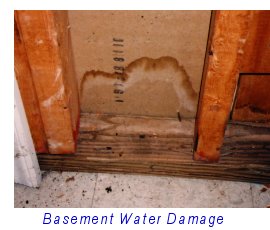 Regularly inspecting your home for
damp areas is another way to prevent a
mold problem. Follow these steps:
Regularly inspecting your home for
damp areas is another way to prevent a
mold problem. Follow these steps:When you enter a room that contains plumbing or is near any water source (including rainfall), notice any water damage. Visit each room that has plumbing at least once each week. If you notice a water leak, repair it immediately. In 24 hours mold can begin to form.
Inspect for water stains that can form on sheet rock, ceilings and floor boards. A damp, musty smell or tiny particles in the air that cause your eyes to water are signs of advancing mold.
If you notice mold growing, quickly clean it up by scrubbing the mold off hard surfaces with bleach (or detergent) and water, then thoroughly dry the area with a towel and/or a fan.
Anytime you open the cabinet under the sink, check for leaks and water stains. Leaks can also form near toilets and in laundry rooms.
In the basement or crawl space of a house, pull back floor insulation to inspect for leaks and wood damage near water supply pipes, drains and toilets.
After a heavy rain, inspect your basement walls for cracks or signs of moisture. Seal cracks, and if you detect wetness try running a fan or portable dehumidifier.
Inspect sinks, tubs and showers for proper drainage. Take out hair from drains. If you have to use drain decloggers, only use those that are approved for the drainpipe in your house.
Inspect the pressure relief valve on the water heater by opening it and seeing if it is working.
Paint is the first line of defense against water and pests. If paint starts to peel, remove it carefully and apply a new coat of paint.
If you have an attic, take the time to look inside with a flashlight and see if any water leaks have formed, and take the time to fix them.
Inspect your roof and siding for damage from water, snow and ice; repair as necessary. For your safety, on an angled roof only a professional roofing contractor should make repairs. Walking on a damp roof can be especially dangerous, so use binoculars to inspect it from the ground. Look for loose, missing or damaged roofing materials. Use roofing cement to reseal damaged shingles. You can secure them further with galvanized roofing nails, covering their heads with roofing cement.
Examine caulk and grout (the cement between tiles) around sinks, tubs and showers and fix any cracks with long-lasting sealants made from silicone or latex. This will prevent water from seeping into the walls. Cracked grout should be chipped out and replaced. Discolored or mildewed caulk should be cleaned with household cleaner.
Check for leaks around your washing machine and dryer, looking at hoses to see bulges, cracks or splits. Replace a hose if excessive wear is detected. Leaks most often form around the washers on the water supply hose.
Home Fires
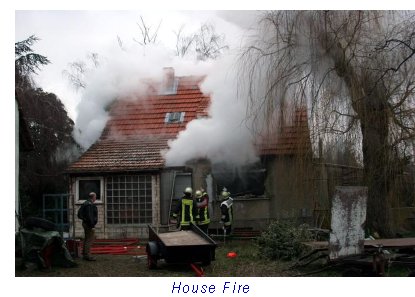 Fires can lead to the total loss of the house and they are also
the leading cause of accidental deaths in the home. Where there
is fire damage there is usually smoke damage as well. Most
residential fire deaths occur because of inhalation of toxic gas,
rather than contact with the flames. The tragedy is that many of
these deaths could be prevented by taking a few precautions. You
should take steps to prevent home fires, make an escape plan for your
household just in case, and be prepared to fight any fire that
does occur. Start by taking these preventative steps:
Fires can lead to the total loss of the house and they are also
the leading cause of accidental deaths in the home. Where there
is fire damage there is usually smoke damage as well. Most
residential fire deaths occur because of inhalation of toxic gas,
rather than contact with the flames. The tragedy is that many of
these deaths could be prevented by taking a few precautions. You
should take steps to prevent home fires, make an escape plan for your
household just in case, and be prepared to fight any fire that
does occur. Start by taking these preventative steps:Every home should have a smoke alarm with the batteries replaced as recommended by the manufacturer, usually twice a year.
Keep all flammable chemicals like fertilizers and turpentine in their original containers and in a storage area separate from the house.
When storing gasoline, use an approved container and keep it in an exterior shed. Do not ever bring gasoline indoors and only use it as motor fuel.
Keep all flammable things away from your fireplace, and use a metal fireplace screen to keep sparks and embers inside it.
Keep matches and lighters in a locked cabinet or drawer, inaccessible by children.
Remain in or near the kitchen when you cook, to stay on watch for kitchen fires. Do not wear loose clothing that could catch fire while you lean over the stove.
Items that can burn (like dishtowels, curtains, paper and plastic bags) should be kept three feet or more from the range top.
Douse matches, cigarettes and cigar butts in water before throwing them away in the trash.
Do not ever leave burning candles unattended and do not allow children to have candles or incense in their rooms. Stable holders for candles are a safety necessity.
Chimney fires can sometimes spread to other parts of the house. Inspect your chimneys, fireplaces, stoves and furnaces once a year and clean as necessary. A professional chimney sweep costs about $100.
A clothes dryer frequently causes fires, often because of lint buildup in the duct venting to the outside. Clean ducts regularly, and/or replace plastic ducts with metal versions.
Never smoke in bed or overstuffed furniture, or leave a burning cigarette in an ashtray.
Keep matches and lighters out of the reach of children, and teach your children about the dangers of playing with fire.
Purchase smoke alarms for each floor of your home.
Clear surrounding brush to protect your home against wildfires or fire spreading from a nearby house.
Make sure your address is clearly visible from the street, so emergency responders can find your home easily.
As a final safeguard against small fires or to keep a small fire from developing into a big one, every home should be equipped with at least one fire extinguisher. A typical fire extinguisher for the home or office should have an "ABC" rating. Keep it at close to full charge (this should be viewable on its gauge). When using one, point it at the base of the flames to extinguish the source of the fire.
Electrical Fires
Don't let this often-overlooked danger jump up and bite you! Simply take the following precautions:Do not load too many appliances onto one power outlet. Older homes especially may need an upgrade to better wiring and/or more circuits to supply today's power-hungry homes.
Do not use damaged or frayed electrical cords or extension cords. Never use any extension cord with heating or air conditioning equipment because that can cause an overload.
If any interior lights dim when you activate a major appliance (or when it turns on automatically, e.g. a refrigerator), this may mean you have bad wiring or too many appliances connected to one circuit.
Flickering lights can be an indication of failing connections in aluminum wiring, a component in homes constructed between 1965 and 1973.
Unusually warm outlets or switches may indicate that an unsafe wiring condition exists. Have an electrician check the wiring as soon as possible.
Ground-fault circuit interrupters (GFCI) can prevent deadly shocks. Outlets in bathrooms (and in kitchens within six feet of the sink) should be GFCI. You know you already have them if your outlets have red and/or black buttons.
Your Escape Plan
Develop an emergency exit plan and an alternate exit plan using the following suggestions:The most obvious way out may be blocked by fire. A window will usually be the second way out of a bedroom. Make sure that screens or storm windows can be easily removed. You may want to get an escape ladder (or a thick knotted rope) for each occupied bedroom.
In the event of fire, do not stop to get dressed or gather valuables. Seconds count - regrettably, you can't afford to search for the family pet.
Stay low to the floor on your hands and knees to avoid smoke and intense heat, which tends to drift upward.
If a door feels warm, open it slowly, and close it quickly if heat or smoke rushes in.
Have a pre-agreed meeting place so everyone knows where to go.
Once you're out, never re-enter the home while there is any fire. As soon as two people have safely escaped, one should call 911 from a neighbor's house or cell phone, while the other looks out for the other household members.
After the fire has subsided, do not enter the home until the fire department says you can. Even though the fire has been extinguished, it can still rekindle. If your home is not destroyed, take all necessary precautions to protect it: board up windows and doors to protect it from looters, and tarp or shrink-wrap the roof to prevent rain damage. Assess all damage promptly to ensure proper insurance compensation. Avoid using electronic appliances until cleaned and checked (empty the refrigerator and freezer while not powered up). Close doors to burned areas to contain smoke odors, while opening windows to ventilate.
Air Pollution Hazards
Carbon Monoxide
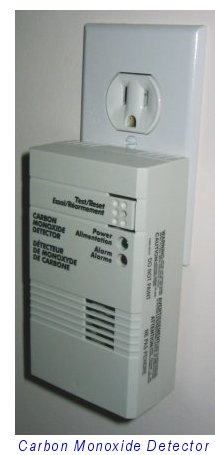 Each year, thousands of other people suffer the effects of carbon
monoxide or "CO"
gas without realizing it because CO symptoms mimic the flu and
other common illnesses. CO can be produced from any fuel-burning
appliance or engine. Mild exposure to CO gives most people a
slight headache, nausea, vomiting, fatigue ("flu-like" symptoms)
followed by a throbbing headache, drowsiness, confusion, and fast
heart rate. If the entire family feels progressively ill after
entering the home, and feels better when they leave the home,
carbon monoxide poisoning should be suspected. To guard against
CO poisoning:
Each year, thousands of other people suffer the effects of carbon
monoxide or "CO"
gas without realizing it because CO symptoms mimic the flu and
other common illnesses. CO can be produced from any fuel-burning
appliance or engine. Mild exposure to CO gives most people a
slight headache, nausea, vomiting, fatigue ("flu-like" symptoms)
followed by a throbbing headache, drowsiness, confusion, and fast
heart rate. If the entire family feels progressively ill after
entering the home, and feels better when they leave the home,
carbon monoxide poisoning should be suspected. To guard against
CO poisoning:Make sure heating appliances are installed and used in accordance with manufacturer's instructions.
Make sure chimneys and vents are unblocked.
Never use charcoal grills indoors, and never heat your home with a gas kitchen range.
Never operate gasoline engines in garages or anywhere indoors.
Gas stoves and ranges should only be operated with the exhaust fan turned on. If the range lacks an exhaust system, one should be installed.
The U.S. Consumer Product Safety Commission recommends that every residence with fuel-burning appliances be equipped with at least one UL-listed CO alarm. If your alarm indicates high levels of carbon monoxide in your home, immediately move outdoors to fresh air and do a head count, then do not re-enter the home until you have called emergency responders and they have arrived, aired out the house, and determined it is safe to re-enter.
Ventless gas heaters, fireplaces, gas logs, faulty furnaces and freestanding kerosene heaters can cause major indoor pollution problems. Emitted gases can include CO, carbon dioxide, sulfur dioxide, water vapor which can lead to mold, and many other hydrocarbons. A gas-heated water heater typically is not a problem because it is vented to the outside. However, your natural gas stovetop range may not have an overhead vent -- if not, it is recommended that you install one.
Radon
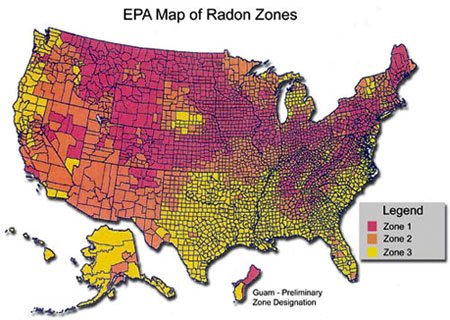 Radon is an odorless radioactive gas that results from the
breakdown of uranium. Some uranium is present in most of the
soil and rock around the world. Exposure to radon can greatly
increase your chances of getting lung cancer. The Environmental
Protection Agency says about 20,000 Americans die of radon-related lung cancer annually. Radon can leak into
your house through the basement or crawl space, or through well
water as you take showers or run the faucet. It can also creep in
as you burn natural gas. The map shows that the northern areas of
America have the most risky "Zone 1" high-radon areas, but radon can
occur anywhere and the EPA recommends that all homes be tested
regardless of their location. When you buy a home, the home inspection
usually doesn't test for radon.
Radon is an odorless radioactive gas that results from the
breakdown of uranium. Some uranium is present in most of the
soil and rock around the world. Exposure to radon can greatly
increase your chances of getting lung cancer. The Environmental
Protection Agency says about 20,000 Americans die of radon-related lung cancer annually. Radon can leak into
your house through the basement or crawl space, or through well
water as you take showers or run the faucet. It can also creep in
as you burn natural gas. The map shows that the northern areas of
America have the most risky "Zone 1" high-radon areas, but radon can
occur anywhere and the EPA recommends that all homes be tested
regardless of their location. When you buy a home, the home inspection
usually doesn't test for radon.The only way to know your radon risk is to have your home tested. You can also monitor radon levels yourself by using an "alpha track" detector, which takes at least a month to determine average radon concentration. Such detectors cost about $20-$25 per kit and can be bought at a home supply store or Amazon.com. The cost of fixing a radon problem may be hundreds or thousands of dollars. Radon levels vacillate, so the detector may take three months to yield a valid result.
Natural Gas Leaks
Natural gas is primarily composed of methane and is highly flammable. Rarely, a natural gas leak can occur inside the home. This can sometimes lead to a fire or explosion. Natural gas is odorless, so the gas company is required to add a warning "rotten-egg" smell that can be easily detected by most people. Another tip-off could be a hissing sound of a leak (don't wait for the smell, just get out!) People who have a diminished sense of smell may need to purchase a natural gas detector. If you smell it, get everyone out immediately! DO NOT make calls from your home because phones are capable of producing a spark which could ignite the gas. Likewise don't light a match, flick any light switches on or off, or plug or unplug any electrical appliances. Contact your local gas utility company from a phone away from your home. Do not re-enter the house until the gas company fixes the leak. To prevent natural gas leaks:When digging deep holes using power equipment, first ask your utility company flag where the lines are.
Don't use basement pipes to hang heavy items.
Inspect the gas connections to your gas appliances to ensure they aren't fraying or cracked (normally they're labeled "gas").
Indoor Smog
Sources of indoor air pollution can include combustion from wood or fuels, tobacco smoke, mold spores, usage of chemicals such as solvents or pesticides, and outdoor pollution entering the home. Health effects from these pollutants may be experienced soon after exposure, including irritation of the eyes, nose, and throat, headaches, dizziness, and fatigue. Usually these effects are short-term and sometimes treatable by eliminating exposure to the pollution. If the symptoms fade when a person is away from home, indoor pollution may be to blame. Sometimes exposure to indoor pollution can result in long-term health problems.With the growing concern about indoor air pollution, many people are wondering how to fix problems with indoor air. You can either (1) somehow fix or eliminate the source of pollution (best), (2) get an air purifier (partially effective) or (3) increase ventilation to the outside. Fans in bathrooms and above the kitchen range usually vent air to the outside, and should be used when cooking with natural gas, using kerosene heaters, painting the walls, and so on. The marketplace has responded with a wide array of appliances promising to "purify" household air. Research shows that most of these appliances work to some degree to remove air contaminants, but some types of purifiers create their own health hazards.
In 1993, the University of Tulsa Center for Environmental Research and Technology conducted a test of 14 air cleaners employing various air-purifying technologies. They found that many air cleaners are partially effective, removing from 28% to 95% of various pollutants. "HEPA" (High Efficiency Particulate Air) filters were found to be the most effective. The "ionizing" air cleaners based on ozone generation were only marginally effective, while none of the units were effective at removing carbon monoxide. The authors noted that while ozone-based cleaners may reduce some pollutants, they will actually produce others. Finally, an air cleaner must be maintained according to the manufacturer's directions in order to remain effective.
Pest Attacks
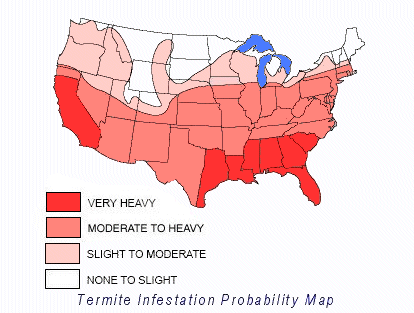
Termite Infestations
Termite damage can be very costly and the sooner you detect them, the easier it is to prevent damage. It costs about $50 for a termite inspection, whereas to get rid of them could cost several thousand dollars -- perhaps more, if you have to replace some major structural components of your house. Termites eat from the inside out, so damage can be difficult to detect. The Formosan subterranean termite is often nicknamed the "Super termite" because of its rapidly destructive habits.Termite Inspections
One very noticeable indicator of termite activity is a large swarm of winged insects inside or near the home in the spring months. But termites sometimes hide from sight for up to 12 years before a swarm is visible.
Another indicator is mud tubes on walls inside or outside the home. The mud tubes are at around 1/4 inch in diameter. These shelter tubes are tunnels constructed by the termites, extending from the soil and/or siding.
Some places to check outdoors are the foundation, porches, window and door frames, entry points for utility lines such as fuse boxes, shrubbery or plants near walls, fences, stairsteps and trellises. Anywhere wood touches ground is especially likely to be troublesome.
Indoors, check all doors, window facings, baseboards and hardwood flooring. Discoloration or stains on walls or ceilings may mean that water is leaking, which can decay wood and aid termite infestation. Inspect where plumbing or utility pipes enter the foundation or flooring. The attic can also be a problem spot for water damage and a resulting termite infestation.
If wood sounds hollow when you knock on it, termites are probably eating your home and the damage may be advanced. Inspect suspected areas with a sharp, pointed tool such as an icepick to find termite galleries or their damage.
If when you remodel or repair your home you notice small, whitish insects that quickly shift away from exposed open air, these are most likely live termites eating your wood.
Dead termites or wings from termites are indicators as well. You may see them near windows, doors, bathtubs, sinks and heating vents.
If termites are detected, quickly contact a professional to rid your house of these pests.
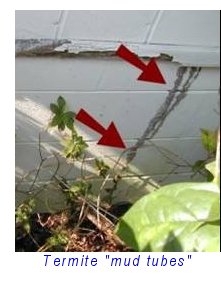
Termite Prevention Tips
To avoid attracting termites to your home structure, do the following:Eliminate all wood-to-soil contacts such as trellises, fence posts, stair casings and door facings (they can be put on masonry blocks or on treated wood)
For home improvements, use wolmanized wood (pressure-treated wood) so that rain will not rot it.
Don't stack firewood and lumber in or against the home structure. Keep the firewood off the ground by using a wood rack or similar device.
Remove all stumps and wood-type debris from under or near the home. Be sure to check your crawl spaces and basement.
Keep your mulch to a depth of no more than two to three inches and never in contact with the house.
Keep landscaped areas a few feet from the home structure, not brushing against the siding or with roots contacting the foundation. Remove vegetation growing close to the foundation or siding: vegetation traps moisture and attracts termites.
For outdoor wooden porches and steps, use a concrete base support.
All woodwork like wood siding, lattice, door frames and window frames should be 6 inches or more above ground level. Any woodwork that is closer to the ground should be regularly inspected.
Water accumulations attract termites, whether on the ground or in the roof. Avoid them whenever possible by keeping the roof dry and water drainage effective. It's best to slope the soil around foundation so water drains away from home structure; if that's not possible, dig a drainage ditch.
A crack in a concrete floor attracts termites, especially if wood is exposed to the ground. Seal all cracks and other openings through the foundation.
If Termites Strike
Termite treatment often requires specialized equipment. Therefore, it is recommended that you always use the services of a pest control operator because he is familiar with construction principles and practices, and has the necessary equipment and knowledge of subterranean termites.Rodents
Mice and rats can carry disease and make messes, and they love to chew through insulation and wiring. Don't tolerate any vermin, or you could have an electrical fire. You can use traps or call in an exterminator: either way, make sure they're killed and removed.Roach Control
To avoid roaches, take these steps:Caulk, weatherstrip, and repair holes around water pipes, baseboards, doors and windows.
Put screens over windows, vents, floor drains and ducts.
Keep areas outside your home free of trash, wood piles and leaves.
Store food in sealed containers. Never leave food, crumbs or trash uncovered anywhere in your home.
Do not leave uneaten pet food out overnight.
If you must leave dirty dishes out overnight, put them in the sink and cover them with soapy water.
Use a trash can with a tight lid and empty it often.
The Human Element
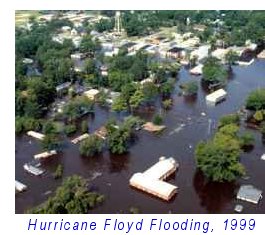 Sometimes people lose thousands of dollars worth of property
because they were just too trusting.
Sometimes people lose thousands of dollars worth of property
because they were just too trusting.
Home Insurance Traps
Your home insurance may not be as comprehensive as you think. Read the fine print and look out for the following traps:Past claims on a home can affect the new homeowner's ability to insure the home. In particular, mold and water-related claims on a home can make the home uninsurable, or else the premiums will be much higher. To avoid high insurance costs, pay small losses with your own money (without informing the insurance company, because they may record it as a black mark on your home's record.)
Hurricanes are usually covered by "HO-3" policies, the most common form of homeowner insurance. Most homeowner policies also don't cover flood damage (whether due to a hurricane or any other cause). They don't cover mudslides, nor is water seepage into your basement covered. Your home insurance can only be counted upon to cover sudden and accidental events: it's not a maintenance contract. Seepage is viewed as a maintenance issue, so see a contractor about waterproofing your basement if you are in a low-lying area with a high water table. If you live in a flood-prone area it may be wise to purchase flood insurance. Flood insurance can be obtained from the federal government, under a program run by the Federal Insurance Administration.
Earthquake coverage is sold as additional coverage to the homeowners policy. The cost of this coverage can vary greatly from one area to another, depending on the likelihood of a major earthquake. Severe earthquakes can occur almost anywhere, but they are very rare away from major fault lines.
Make A Household Inventory
Make an inventory of your household possessions, making a list of everything you own. If you are burglarized or a disaster strikes, this list will help you prove the value of what you owned if those possessions are damaged or destroyed. You'll likely receive a fast, fair payment from your insurance company for your losses. It will also supply proof for the tax deductions you claim for your losses. To conduct a thorough home inventory:Record the location of the originals of all important financial and family documents, such as birth and marriage certificates, wills, deeds, tax returns, insurance policies, and stock and bond certificates. Keep the originals in a safe place and store copies elsewhere. You'll need accessible records for tax and insurance purposes.Update your home inventory annually. If this sounds like too much work, computer software specially designed to maintain a home inventory can make the task much easier. Once you have completed your inventory, it's vital to leave a copy with relatives or friends, or in a safe deposit box. Don't leave your only copy at home, where it might be destroyed. For more information on this subject, visit https://www.iii.org/article/how-create-home-inventory.
Make a visual or written record of your possessions. If you don't own a camera or videotaping equipment (and can't borrow or rent it), buy an inventory booklet and fill it out, or make a simple list on notebook paper. Ask your insurance agent if he or she can provide one.
Go from room to room. Describe each item, when you bought it, and how much it cost. If you're photographing or videotaping, have someone open closet doors and hold up items.
Record model and serial numbers.
Include less expensive items, such as bath towels and clothes. Their costs add up if you have to replace them.
Be sure you include items in your attic, basement, and garage.
Note the quality of building materials, particularly for such furnishings as oak doors or expensive plumbing fixtures.
Photograph the exterior of your home. Include the landscaping- that big tree in the front yard may not be insurable, but it does increase the value of your property for tax purposes. Make special note of any improvements, such as patio, fencing, or outbuildings.
Photograph cars, boats, and recreational vehicles.
Make copies of receipts and canceled checks for more valuable items.
Get professional appraisals of jewelry, collectibles, artwork, or other items that are difficult to value. Ideally you should update the appraisals every two to three years.
Con Men Contractors
Most contractors are honest, but when you hire a contractor to do extensive work on your home (such as repairing water damage or replacing a roof) you should always take precautionary measures just as you should whenever a large amount of money is at stake. Use the following tips:Check with your state to make sure that contractor has a license, and check with the Better Business Bureau to see if they have a good reputation. Ask how many projects like yours the contractor has done recently, and ask for references for those projects.
Beware of "lowball artists" who intentionally bid below legitimate competitors. They may take your money and run, or else make expensive mistakes and leave you with a messed-up job and an empty wallet.
Door-to-door home contractors are seldom reliable and are sometimes criminal.
Take your time to check out any contract that's presented to you, and make sure it has the details you want before signing it. Don't let anyone pressure you!
Get more than one opinion or bid when making costly improvements or repairs. A good home inspector can give you professional advice.
Try to limit your down payment, and make further payments contingent on completing a stage of the project.
Make sure the job is done right. One report tells of a sharpster who told a widow he had completed an entire roofing job, pointed out how well he did it from the front yard, and asked for payment... but a few hours later she looked at the other side of the roof and there she saw the same old worn-out shingles!
Burglars
The average burglary results in a loss of $1,700 to the homeowner. There are four layers of home security you might improve:Hide your valuables. A safety deposit box at a bank is best. Many burglars are very thorough, even looking in the toilet tank for hidden jewelry! You need a hiding place that would force a burglar to use his intelligence and expend his precious time to get to it: the attic or kitchen is usually best.
Scare them off. A decent alarm system can do this, especially if a security firm monitors it. When installed correctly that's the best way to improve your home's safety, and it also alerts you to any intrusion. A dog or two is a good alternative, but a "window of vulnerability" is created during vacations if you board them in a kennel. You can post warning signs about dogs or security systems (but don't tip off burglars to which security firm or system you're using). Also, burglars are reluctant to hit well-lit homes that provide no cover to hide from watchful neighbors.
Fool 'em. Try to make your home look average from the outside: in particular, keep displays of valuable items away from windows. Any stranger you invite into your home should be considered a possible scout for burglars. When you leave home, use timers to automatically turn some lights on and off. Keep your curtains closed so burglars can't see that nobody's home. When you're gone for a long time ask neighbors to pick up mail every evening, and have them spend some time in your home to make it look "lived in" (e.g. opening and closing drapes). Everyone in your household should be instructed to never tell people when you'll be away from home.
Lock it down. You must secure all doors and windows because any burglar will exploit the weakest point of entry. Many people who think their homes are secure actually have one or more vulnerabilities. All your exterior doors should be steel or solid wood, especially the back door (if an exterior door swings as easily as your interior doors, you know it's not solid wood.) The screws in the frame should be at least 2.5 inches long. Each door should have a security bump-proof door lock costing $150 to $250 installed, which you can get by calling a locksmith in your area. Any garage door that does not have an automatic garage door opener should be padlocked. Any sliding windows should be secured by locks or pins (not just latches), and any sliding glass door should be (a) made impossible to lift out of its track by drilling screws into the track it slides along, and (b) either equipped with an extra lock, or immobilized with a window pin. If your home has any of these vulnerabilities, it is considerably less secure.
Home Accidents
Falls
Accidental falls are a more common cause of death in the home than fires, especially for elderly people. To safeguard against this tragedy, use these protective measures:Install grab bars in all bathrooms and shower stalls. Firmly anchor them into the wall studs with long screws and follow the manufacturer's instructions carefully.
Use a non-slip mat, or install strips or decals in bathtubs and showers to help prevent slipping.
To provide sufficient lighting, use night-lights near bathrooms, bedrooms and stairwells. Make sure stairwells and hallways are always well lit – especially at night. Provide sufficient lighting to all walkways and entrances to the home.
Keep your floors clear of anything that may cause tripping. Pick up hazards such as toys, shoes and magazines.
Don’t use chairs or tables as makeshift ladders. Many people are seriously hurt when they lose their footing.
Teach your children not to run indoors or jump down stairs.
Poisoning
Poisoning is one of the most frequent causes of death in the home, most often resulting from incorrect dosages of drugs (whether legal or illegal). Know what to do:Signs of poisoning can include sudden illness, unusual sleepiness, eyes going around in circles, vomiting or other strange behaviors. You may detect burns or stains around the lips or mouth, strange smells - especially on the breath, and opened or spilled medicines, alcohol, or cleaning products.
If you think the poison was a cleaning or decorating product, follow the first-aid steps on the label. Then call the Poison Control or your doctor.
Every Poison Control Center in the country can be reached by calling the AAPCC* nationwide hotline, 1-800-222-1222. Post this number, along with your other emergency numbers, by your phone. Experts will answer your call 24 hours a day, seven days a week. Always check with Poison Control or your doctor before giving your child anything if they have been poisoned.
When you call Poison Control or your doctor, tell them: your child's age, height, and weight, any health problems your child has, what the poison was, how it was taken (e.g. swallowed, breathed in, splashed on the eyes), and whether your child has vomited. If you are told to make a child vomit, give either (but not both): syrup of ipecac as instructed to encourage vomiting, or activated charcoal which inhibits the spread of the poison through the body.
Make sure the following are in their original containers and in a locked cabinet: all medications, caustic cleaning products (example: drain openers, toilet and oven cleaners, detergents, rust removers, etc.), automotive fluids (example: windshield washing solution and antifreeze), pesticides, alcohol (drinking or rubbing), medicines, vitamin pills, makeup, mouthwash, first aid supplies, deodorants, perfumes, cigarettes, liquor, furniture polish, lamp oil, some plants, anti-freeze, fuel, car polishes, paints, paint removers, mothballs, bug spray, road salt, fertilizer and other household chemicals.
If you have children, insist on child-resistant packaging. Close caps tightly after using medicines and household products. Lock medicines and household products up high so children can’t see or reach them. Put poison warning stickers on products (you can buy them in the home improvement aisle of department stores) and teach your children what they mean.
Before taking multiple medications, make sure the pharmacist says that mixing them in your bloodstream will not be harmful.
Natural Disasters
Earthquakes
The three most important points are to (1) Earthquake-proof your home, (2) keep emergency supplies on hand, and (3) teach family members what to do if an earthquake happens. Keep in mind that in an earthquake, loose objects cause most of the injuries and deaths. Cabinets shake and bookcases topple. Doors slam shut and window glass shatters. Objects mounted on walls shake loose and fly through the air.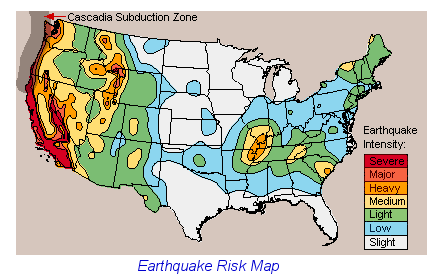
The Earthquake Risk Map shows the severity of earthquakes that may occur. The type of earthquake that has hit America in the past century is unlikely to topple well-built modern homes: earthquake codes require them to withstand quakes up to about 7.8 in magnitude, or even 8.5 for specially quake-proofed buildings. Older buildings would have trouble standing up to even a 7.5 quake. Structural damage can range from falling pieces to general collapse.
An 8.0 quake could occur along the Pacific rim or near Yellowstone Park, while a 7.5 quake might occur in the orange-colored areas of the above map. A 7.5 quake near a major city might cause tens of thousands of fatalities. Then again, the biggest earthquake this century -- the 9.5 1960 quake in Chile -- killed only 2,000 people, largely because foreshocks caused most people to run out into the street beforehand. The northwest coast is a special case because while quakes are less frequent there, a very intense 8.5 - 9.0 quake in the deep Cascadia Subduction Zone occurs about twice in a millennium. The next big quake in this zone is thought by some experts to be due to happen 100-300 years from now, but it could come sometime this century.
To prepare your household, go through your home and inspect for the following dangerous situations:
Notice objects or situations that might damage or injure someone or cause a loss of property by falling, breaking or causing a fire.
If an object or piece of furniture isn't secured, consider your options: you could remove it, move it to a more secure location, or fasten it to the wall or the floor.
Be sure to secure bookcases, the water heater, gas appliances, furnaces, stoves, and any furniture on rollers.
Make certain hallways and exits remain clear of objects that fall during an earthquake: that could obstruct someone's escape from the home.
Place heavy objects on lower shelves.
Move beds and cribs away from windows and lock their wheels.
Household members should know how to shut off gas, water and electricity because earthquakes can break pipes or expose wires. Keep a suitable wrench near the main shut-off values.
An earthquake emergency kit is necessary because you could be on your own for two or three days. Have on hand a fire extinguisher, flashlight with extra bulbs and batteries, battery-operated radio, and a first aid kit.
Teach your family that at the first sign of an earthquake, everyone should drop to the ground and take cover. The best way is to get under a stable piece of furniture such as a table to protect from falling debris. Laying down next to a stable piece of furniture such as a couch is better than nothing. Running outside is usually not safe because many injuries in an earthquake happen to people when something falls on them as they're moving.
Hurricanes
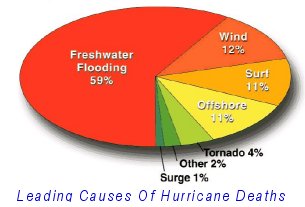 Hurricane hazards include storm surge, high winds and inland
flooding. Storm surge is seawater that is pushed toward the shore
by the force of the hurricane winds. It can increase the water
level by 15 feet or more, and wind-driven waves can push the
water even higher. Much of Atlantic and Gulf Coast coastlines
lie less than 10 feet above mean sea level, so the danger from
storm tides is very serious. Intrusions of salt water endanger
the public health and send animals, such as snakes, to flee from
flooded areas and take refuge in urban areas.
Hurricane hazards include storm surge, high winds and inland
flooding. Storm surge is seawater that is pushed toward the shore
by the force of the hurricane winds. It can increase the water
level by 15 feet or more, and wind-driven waves can push the
water even higher. Much of Atlantic and Gulf Coast coastlines
lie less than 10 feet above mean sea level, so the danger from
storm tides is very serious. Intrusions of salt water endanger
the public health and send animals, such as snakes, to flee from
flooded areas and take refuge in urban areas. Hurricane-force winds can easily destroy poorly constructed buildings and mobile homes. Debris such as signs, roofing material, and small items left outside become flying missiles in hurricanes. Extensive damage to trees, towers, water and underground utility lines (from uprooted trees), and fallen poles cause considerable disruption. Tropical storm-force winds (less than 75 miles per hour) are strong enough to be dangerous to those caught in them. For this reason, emergency managers plan on finding shelter before the onset of tropical storm-force winds, not waiting for hurricane-force winds. The strongest winds usually occur in the right side of the hurricane. Wind speed usually decreases significantly within 12 hours after landfall. Nonetheless, winds can stay above hurricane strength up to 250 miles inland.
Inland flooding can be a major threat to communities hundreds of miles from the coast, as intense rain falls from these huge tropical air masses. Flooding usually kills more people than the hurricane-force winds.
Here are the precautions you should take:
Find out if your home meets current building code requirements for high-winds: for more info visit the Institute for Business & Home Safety Codes and check your state's home safety code. Know what category of hurricane your home can resist.Here's what to do when a hurricane approaches:
In highly flood-prone areas, keep materials on hand like sandbags, plywood, plastic sheeting, plastic garbage bags, lumber, shovels, work boots and gloves. Call your local emergency management agency to learn how to construct proper protective measures around your home.
Stock non-perishable emergency supplies and a Disaster Supply Kit.
Learn your vulnerability to flooding by determining the elevation of your property.
Protect all windows by installing commercial shutters or preparing 5/8 inch plywood panels.
Garage doors are frequently the first feature in a home to fail. Reinforce all garage doors so that they are able to withstand high winds.
Designate an interior room with no windows or external doors as a “Safe Room” (but only stay there if you are not in an evacuation zone.) Listen to your radio and go to your safe room when directed to do so. Do not leave your “Safe Room” until directed to do so by local officials, even if it appears that the winds calmed (remember that there is little to no wind in the eye of a hurricane.)
Before hurricane season, assess your property to ensure that landscaping and trees do not become a wind hazard. Trim dead wood and weak / overhanging branches from all trees.
Use the evacuation routes designated by authorities. Be aware of streams, drainage channels and areas known to flood, so your evacuation routes are not cut off. Avoid driving into water of unknown depth because moving water can quickly sweep your vehicle away. Do not wait or delay your departure and minimize the distance you must travel to reach a safe location; the longer you wait and the further you drive, the higher the likelihood of getting stuck in traffic. Plan for significantly longer travel times than normal to reach your family's intended destination.After the hurricane, do not drink water until assured that it is safe, pump out your well if you have one, and don't eat any food that has come into contact with flood waters. Stay well away from any downed power lines.
You may want to choose the home of a closest friend or relative (discuss your plan with them before hurricane season.) You could also stay in a hotel/motel, but there may be no vacancies. Finally, there are public shelters (preferably within your local area.)
Make plans for pets (most public shelters do not accept them) and for anyone in your household who may require special assistance in order to evacuate.
Before leaving, fill your car with gas and withdraw extra money from the ATM.
Prepare your home prior to leaving by boarding up doors and windows, securing or moving indoors all outside objects that could become a projectile in high winds, and turning off all utilities.
Take all prescription medicines and special medical items, such as glasses and diapers.
Stay tuned to a local radio or television station and listen carefully for any advisories or specific instructions from local officials.
Tornadoes
You can take these preventative measures to survive a tornado:Have a pre-determined plan should a tornado warning be issued and make sure everyone in the household is familiar with it.
Pay attention to tornado watches and warnings. The Weather Channel makes available a free Weather App for portable devices that provides weather alerts. Weather radios can also provide an alarm in case a severe weather advisory is issued for your area .
When a warning is issued, going to a basement or storm cellar is best. A good second choice is an interior first-floor room of a sturdy building.
If in a car and you see a tornado, park it far to the side of the road (to avoid blocking traffic), and find a sturdy shelter.
If no sturdy shelter is available, lie down flat in the lowest possible ground (e.g. a ditch) with your hands over your head.
A common mistake is to get under a highway overpass. They are actually one of the worst places to take shelter, because they can create a "wind tunnel" effect that funnels debris towards you at a high wind speed.
Lightning
Lightning kills more people than hurricanes or tornadoes. Ten times as many people are injured by lightning as killed, and those people often suffer lifelong disabilities. Here's how to protect against lightning:Remain aware of the weather forecast and plan your outings accordingly. If a storm is developing nearby, consider seeking shelter even before the first lightning strike (because who knows if it will happen to land on you?)
When you see lightning, count the seconds until you hear thunder: If this time is 30 seconds or less, lightning is close enough that you should seek shelter.
Lightning is attracted to trees, poles, water, metal objects and high ground, so avoid them on your way home (as much as is possible.)
The National Lightning Safety Institute recommends that when lightning is near, you should get inside a permanent building (not just a shack) and make sure loved ones do the same.
If you can't make it home, getting inside a vehicle is your next best option, even if it is made of metal (but lean away from the doors and don't touch any car parts, including the steering wheel.)
As trees are natural lightning conductors, having trees near your home provides some protection against lightning damage. Installing a lightning rod system can cost $2000 or more, but if your home is isolated and on high ground it may be worth the money.
To prevent damage to your more valuable electrical appliances from lightning strikes, it is wise to plug a quality surge protector into the outlet (these are commonly available in hardware and department stores.)
Drownings
This may be a little outside the focus of this report, but because it's flood-related let's cover it anyway. Observe the following precautions when near water:Keep watch on all youngsters who go near the water, especially when they have inflatable water toys (they might try to go too far.)
Don't do unsafe things like swimming alone, walking on ice, swimming in cold water, ignoring strong currents or rough seas, or swimming soon after a meal (or after drinking).
When boating remember to get the weather report before going out, wear lifejackets, have at least one radio, and don't get stranded out at sea.
Basic Disaster Supplies Kit
A basic disaster supplies kit will help you get through disasters comfortably, and might save your life. The following items are recommended for inclusion in your kit:Three-day supply of non-perishable food.
Three-day supply of water - one gallon of water per person, per day.
Portable, battery-powered radio or television and extra batteries.
Flashlight and extra batteries.
First aid kit and manual.
Sanitation and hygiene items (deodorant, toilet paper, etc).
Matches and waterproof container.
Extra clothing.
Kitchen accessories and cooking utensils, including a can opener.
Photocopies of credit and identification cards.
Cash and coins.
Items for infants, such as formula, diapers, bottles, and pacifiers.
Special needs items -- prescription drugs, eyeglasses, contact lens solutions, & hearing aid batteries.
Other items to meet your unique family needs.
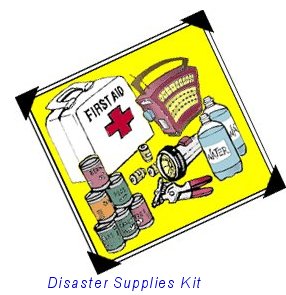 If you live in a cold climate, you must think about warmth. It is
possible that you will not have heat. Think about your clothing
and bedding supplies. Be sure to include one complete change of
clothing and shoes per person, including:
If you live in a cold climate, you must think about warmth. It is
possible that you will not have heat. Think about your clothing
and bedding supplies. Be sure to include one complete change of
clothing and shoes per person, including:Jacket or coat.Update your kit periodically to account for growing children and other family changes. See Appendix B for a detailed checklist of disaster supplies. You may want to add some of the items listed to your basic disaster supplies kit depending on the specific needs of your family.
Long pants.
Long sleeve shirt.
Sturdy shoes.
Hat, mittens, and scarf.
Sleeping bag or warm blanket (per person).
Maintaining Your Disaster Supplies Kit
Just as important as putting your supplies together is maintaining them so they are safe to use when needed. Here are some tips to keep your supplies ready and in good condition:Keep canned foods in a dry place where the temperature is cool.
Store boxed food in tightly closed plastic or metal containers to protect from pests and to extend its shelf life.
Throw out any canned good that becomes swollen, dented, or corroded.
Use foods before they go bad, and replace them with fresh supplies.
Place new items at the back of the storage area and older ones in the front.
Change stored food and water supplies every six months. Be sure to write the date you store it on all containers.
Re-think your needs every year and update your kit as your family needs change.
Keep items in airtight plastic bags and put your entire disaster supplies kit in one or two easy-to-carry containers, such as an unused trashcan, camping backpack, or duffel bag.
Create An Evacuation Box
Buy a lockable, durable "evacuation box" to grab in the event of an emergency. Even a cardboard box would do. Put important papers into the box in sealed, waterproof plastic bags. Store the box in your home where you can get to it easily. Keep this box with you at all times, don't leave it in your unattended car. The box should be large enough to carry:A small amount of traveler's checks or cash and a few rolls of quarters.
Negatives for irreplaceable personal photographs, protected in plastic sleeves.
A list of emergency contacts that includes doctors, financial advisors, clergy, reputable repair contractors, and family members who live outside your area.
Copies of important prescriptions for medicines and eyeglasses, and copies of children's immunization records.
Health, dental, or prescription insurance cards or information.
Copies of your auto, flood, renter's, or homeowners insurance policies (or at least policy numbers) and a list of insurance company telephone numbers.
Copies of other important financial and family records (or at least a list of their locations). These would include deeds, titles, wills, a letter of instructions, birth and marriage certificates, passports, relevant employee benefits documents, the first two pages of the previous year's federal and state income tax returns, etc. Originals, other than wills, should be kept in a safe deposit box or at another location.
Backups of computerized financial records.
A list of bank account, loan, credit card, driver's license, investment account (brokerage and mutual funds), and Social Security numbers.
Safe deposit box key.
Take jewelry and other small valuables.
Irreplaceable heirlooms, mementos, and photos.
A battery-powered radio and spare batteries so you can stay informed.
Important papers and computer disks if you have a home business.
Final Thoughts
Performing routine home maintenance regularly can save you thousands in repair bills later. And taking good care of your home will make sure that it's value rises faster. This Special Report has given you the keys to preventing disaster. To make sure you're doing everything right, dig out those warranties and product manuals and read up on recommended maintenance for air conditioners, furnaces and other high-maintenance appliances.Another good way to catch small problems before they become big ones is to hire a home inspector about every five years for about $300. You can find a qualified home inspector at the site of the American Society of Home Inspectors (https://www.homeinspector.org/).
© 2010, LifetimeSuccessMakeover.com. Much of the above is researched from publications produced by government agencies responsible for public safety.
